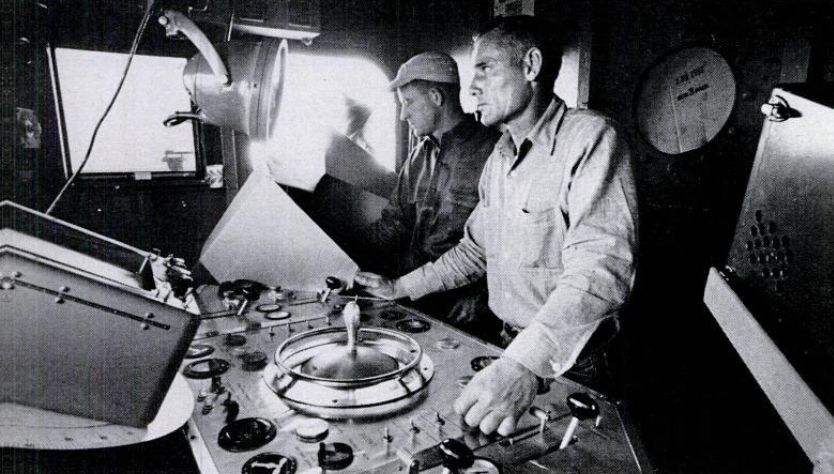
“A Foolish and Unjustifiably Expensive Fiasco”: the beginnings of ocean drilling
Normally my territory is an elementary school gym. On an average Monday I’d be somewhere in the rural American Midwest, getting too excited about supernovae and setting off liquid nitrogen rockets. The life of a museum outreach educator.
Instead of all that, right now I’m in the South Pacific Ocean. I’m writing to you from my office, at the corner of a lab stack that’s attached to a boat that just finished hovering over a hole in the seafloor 1.2 kilometers below. The reason I’m here to begin with, why any of us are here on a drilling ship in pursuit of science, is because of two geologists meeting in a cramped, stuffy office in 1957. This meeting is the beginning of Project Mohole, a failed scientific feat from whose ashes would eventually rise the scientific ocean drilling we do today.
Illegitimi Non Carborundum
The two geologists are Harry Hess and Walter Munk, and they are not impressed with a single grant proposal that has come across their desks. Hess and Munk start brainstorming ways to move the geosciences into the modern age. What question will excite the American public, make them clamor to the television every night for the hope of scientific updates, in the way that space probes and telescopes did at the time? If they had unlimited funding, infinite public support – what would it be?
Their answer: drill a hole to the mantle. The physical opposite but ideological cousin of the Apollo missions: exploring the unexplored.
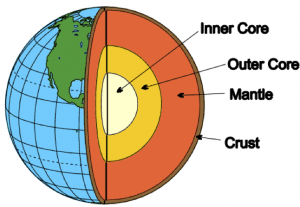
Just saying “drill a hole into the mantle” doesn’t quite reveal the scope of what Hess and Munk had just proposed. If you need a refresher from high school science, the mantle is the middle layer of the Earth. On top of the mantle sits the crust, made of solid rock, and atop the crust is the ocean and soil that we’re familiar with. Below your average land mass, the mantle is about 18 miles / 30 kilometers straight down. Oceanic crust is thinner – the mantle is only about 3 miles / 5 kilometers beneath. Continental crust is more to drill through, but the logistics of drilling in the ocean pose a more extreme technological hurdle.
Among any other company, this massive feat might have been dismissed out of hand. Instead, Hess brings it to the attention of a group known as the American Miscellaneous Society.
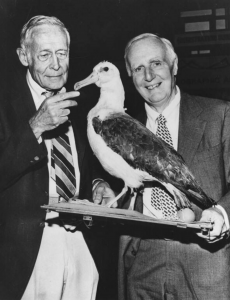
To really grasp the coming story, you must have an idea of what the American Miscellaneous Society was all about. The Society was a group of geoscientists, all together under two commonalities: they enjoyed each other’s company and they hated formalities. (Technically three commonalities: they were all older white men. That’s science in the ’50s for you.) Their motto was “Illegitimi non Carborundum” – a (completely incorrect) Latin translation of don’t let the bastards grind you down. The Society had an award, given out sporadically, called the Albatross Award (the physical award was a taxidermied albatross stolen from a storeroom at Scripps Institute of Oceanography). Cited reasons for being gifted the Albatross include: “for the study of the oceans and other liquids after 5:00 PM”; “for coveting the bird above all else”; “for outrageous insistence that ocean circulation models should bear some resemblance to reality”; and finally, “for conceiving the award.”
Frivolity aside, the men of the American Miscellaneous Society were some seriously heavy hitters in the world of Earth science. The core “in-group” had representatives from the Office of Naval Research, the U.S. Geological Survey, Woods Hole, Lamont-Doherty, Scripps, Princeton, Texas A&M, University of Washington – the list goes on. And their associations with each other, and with military higher-ups from their tours in World War II, meant that they’d unlocked a level of nepotistic control over scientific funding that few academics have ever come close to.
Also working in their favor was timing. This was the early Space Race, where the right kind of scientist couldn’t walk from the office to the bus stop without being awarded government grant money. Science was a massive priority within the U.S. government and Earth scientists wanted their chunk. So, knowing the system from the inside, the group puts together a National Science Foundation (NSF) grant and submits it under the mysterious name “AMSOC committee.” They had chosen the ocean as their entry point to the mantle; much less to drill through, but with an impossibly steep engineering curve to get past.
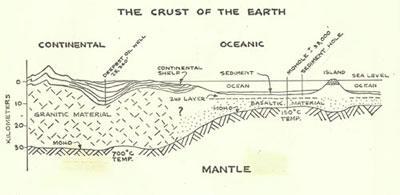
Today we have oil wells off the coast of every continent, drilling off the coast all the time with little incident. This was not so in the ’60s. Offshore drilling for oil was relatively new, and the previous record for drilling water depth was just under 400 ft / 120 meters. For reference, the thinnest crust on the Earth’s surface sits under 25,000 feet / 7,500 meters of water.
The AMSOC folks are awarded the grant – $2.5 million to begin the project, with NSF and AMSOC sharing responsibility. This little ambition had taken on the name Project Mohole, an awfully silly portmanteau for such an immense project. The Mohorovičič discontinuity is the name for the boundary between Earth’s crust and mantle, usually shortened to Moho. And well, they were trying to drill a hole in it, so Mohole it became.
Project Mohole would come in three phases: Phase I, to test out drilling strategies. Phase II, to build an “intermediate vessel” which would conduct smaller scientific drilling operations and retrieve seafloor cores. Phase III? The Mohole, and the weirdly sinister-sounding “ultimate vessel.”

For all their previous goofing off, the AMSOC folks got their act together quickly – in 1961 they pull off the world’s first scientific ocean drilling expedition using a borrowed oil ship called the Glomar CUSS I. They do a test drill near California, then a longer drill off the coast of Mexico. They had broken the previous ocean drilling record by almost a kilometer, and the scientists of the CUSS I were the first people in human history to hold oceanic crust in their hands.
Phase I was a success, but it was one of the last successes the AMSOC folks would see.
Project No Hole
Here’s the problem: the American Miscellaneous Society by nature was allergic to structure. Before the creation of the “AMSOC committee” there was no membership roster, no induction process, and no agenda. Any committees in the Society before this point consisted of things like Cooperation with Visitors from Outer Space and Informing Animals of their Taxonomic Positions. The NSF is also not an operations-based organization, which means that AMSOC and NSF were engaged in the most expensive game of Hot Potato every played – NSF trying to pawn the execution of Phase II off onto contractors, while AMSOC developed a laundry list of organizations and committees trying to re-appropriate control every so often.
In 1962 the NSF complied a list of contractors to build the vessel that would drill to the mantle – three oil companies and two engineering firms. Even though the front runner, Socony Mobil Oil Company, had a proposal that was “outstanding as to every aspect,” after several rounds of budgeting the contract was awarded to the last-place contender, a firm called Brown & Root out of Houston, Texas. This was never outright linked to corruption, but some at the time found it suspicious that George Brown (of the eponymous Brown & Root) was a known business associate of Albert Thomas, the chairman of the relevant House Appropriations subcommittee.
Meanwhile things at AMSOC weren’t going any better. AMSOC had just changed chairmen, and the new one was not the amiable American Miscellaneous Society sweetheart that the last guy had been. The new chairman, Hollis Hedberg, was the kind of guy who threatened to resign over a letter that said NSF was considering the idea of hiring a new scientific director for Mohole. Moreover, he believed the project needed two ships – one for Phase II, one for Phase III. Which makes sense until you remember that Brown & Root was awarded a contract to build one ship and one only.
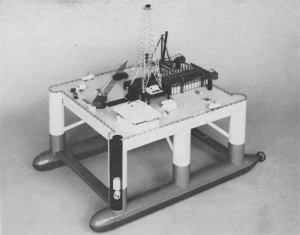
So Brown & Root came back with a proposal in 1963, again channeling their inner super villains with a drilling platform held up by six huge columns, each side mounted to its own submarine. The project was quoted at $40 million, and the vessel would cost $9 million to operate every year they spend drilling (estimated to be 3 years). For reference, in today’s terms that’s $338 million for construction alone – almost a quarter of NSF’s entire budget in 2019.
Of course, Hedberg is still committed to the “intermediate vessel.” Almost immediately, Hedberg and the main committee reject the proposal, in direct opposition to AMSOC’s own drilling panel, who said the proposal “offers the best solution of the requirements for both [phases].”
The Mohole budget had ballooned from $4 million to $70 million within a few years, a fact which gained quite a bit of public attention. In the autumn of 1963, the relevant Congressional subcommittees got together with the NSF to investigate the details of the project. Mohole had become the albatross around the necks of the NSF – what once seemed like a good idea had turned into a source of endless government scrutiny and public ridicule. Almost for the first time since this whole project started, Congress asked the men of AMSOC to justify their approach with Project Mohole. Hedberg, never one to let a fight get out from under him, said at the Congressional hearing that he would “far rather see this project killed where it now stands than to see it carried out in a manner not worthy of its potentialities.”
Well, Hedberg got what he asked for.
The final blow came in 1966, when AMSOC applied for over $125 million in government grants to build the ultimate vessel proposed by Brown & Root. Lacking confidence in Mohole and bleeding money from the Vietnam War, Congress denied their application and Project Mohole was abandoned. The U.S. government had doled out about $57 million, equivalent to nearly $470 million today, and received a kilometer or two of core plus a heaping of public shame. In 1980 Walter Munk wrote that he had been “trying to forget [Mohole] for twenty years.”
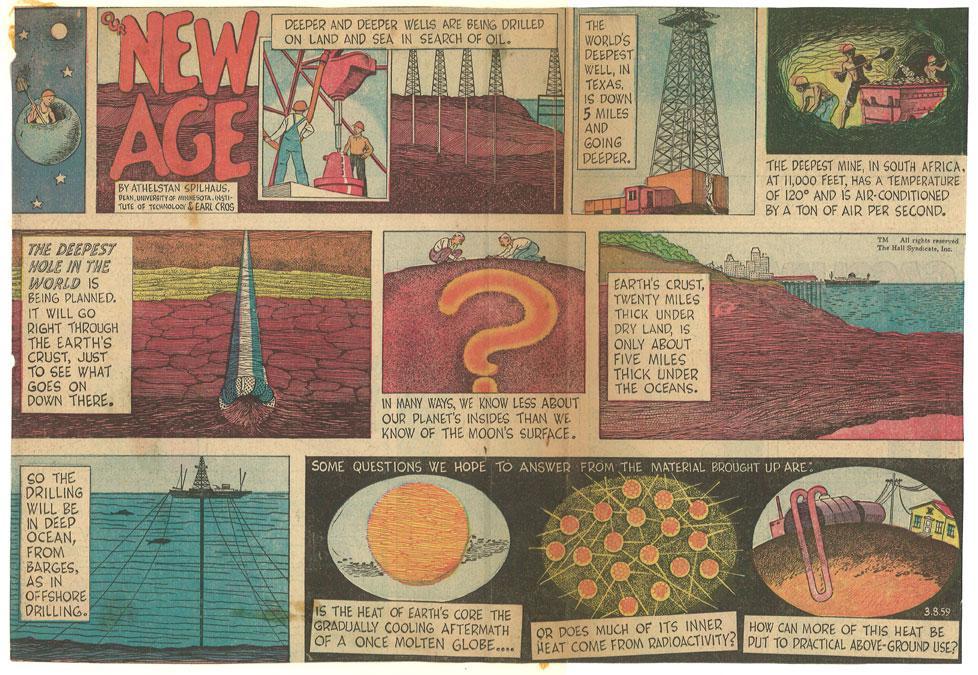
A Manner Worthy
The geoscientists of the American Miscellaneous Society might have just been a silly little blip in science history, except for one fact. After the success of Mohole Phase I, some of the original Project Mohole people decided to unite their institutions’ efforts around ocean drilling – the “intermediate vessel” kind of drilling that yielded cores for pure scientific study. They wrote an agreement establishing themselves as the Joint Oceanographic Institutions for Deep Earth Sampling. If you’re keeping track of acronyms, you know where this is headed.
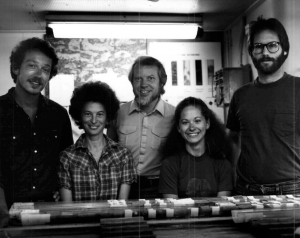
In 1963, the Joint Oceanographic Institutions had applied for a modest chunk of change to begin drilling for deep sea sediment, and won the money. They contracted Global Marine to build them a ship, the Glomar Challenger, using a more sophisticated version of the dynamic positioning system that had allowed the CUSS I to hover over that very first drill site. Within 3 expeditions the Challenger proved her worth – the basalt recovered at the Mid-Atlantic Ridge was exactly the age predicted by the theory of seafloor spreading, rocketing plate tectonics from a mere hypothesis into science textbooks everywhere.
After the Challenger was retired in the mid-’80s, a new vessel was chosen to replace it – an oil drillship called Sedco/BP 471. Because scientists are a sentimental bunch, she didn’t keep that name for long. The ship’s new name was chosen to honor her institutional heritage, plus an explorer that came before: The JOIDES Resolution.
And this brings us to today.
Today I’m sailing on the three hundred and seventy eighth expedition of the International Ocean Discovery Program. We never did drill that Mohole, but we have recovered over 400,000 meters of seafloor sediment from every ocean in the world. Were it not for Hess and Munk and the AMSOC crew, the confirmation of plate tectonics may have been decades delayed. Our understanding of geologic time would be much lower-resolution than it is today. The disappearance of the dinosaurs and 75% of Earth’s animal life along with them might still be a scientific mystery.
Hollis Hedberg said in 1963 that Mohole was at a tipping point: it could become one of the greatest ever scientific ventures, among the ranks of the Apollo missions and the Hubble Telescope, or it could become “only a foolish and unjustifiably expensive fiasco.” What Hedberg didn’t see was the third option. Ocean drilling became the silent workhorse in our understanding of the Earth, populating our science textbooks and filling in our geologic time scale. The JOIDES Resolution works day and night, the whole year round, through holidays and adverse weather and unpredictable conditions, all to contribute its share to science.
Although we never ended up drilling the Mohole, we can be forever grateful for this new discipline of science it gave to us. And so I propose one final Albatross Award to the members of the American Miscellaneous Society: for an extravagantly ridiculous project idea with an unexpectedly brilliant outcome.
LN